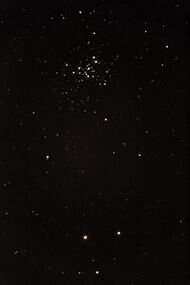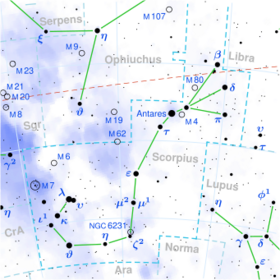Astronomy:Zeta1 Scorpii
| Observation data Equinox J2000.0]] (ICRS) | |
|---|---|
| Constellation | Scorpius |
| Right ascension | 16h 53m 59.727s[1] |
| Declination | −42° 21′ 43.31″[1] |
| Apparent magnitude (V) | 4.705[2] (4.66 to 4.86)[3] |
| Characteristics | |
| Spectral type | B1.5 Iae[4] |
| U−B color index | −0.567[2] |
| B−V color index | +0.480[2] |
| Variable type | cLBV[5] |
| Astrometry | |
| Radial velocity (Rv) | −26.0[6] km/s |
| Proper motion (μ) | RA: 0.009[1] mas/yr Dec.: −2.939[1] mas/yr |
| Parallax (π) | 0.7131 ± 0.2420[1] mas |
| Distance | 2,520[7] pc |
| Absolute magnitude (MV) | −8.5[4] |
| Details | |
| Mass | 36[4] M☉ |
| Radius | 103[4] R☉ |
| Luminosity (bolometric) | 850,000[4] L☉ |
| Surface gravity (log g) | 1.7[4] cgs |
| Temperature | 17,200[4] K |
| Rotational velocity (v sin i) | 60[8] km/s |
| Age | 6.5 ± 0.1[9] Myr |
| Other designations | |
| Database references | |
| SIMBAD | data |


Zeta1 Scorpii (Zeta1 Sco, ζ1 Scorpii, ζ1 Sco) is a B-type hypergiant star in the constellation of Scorpius.[10] It has an apparent visual magnitude which varies between 4.66 and 4.86.[3] It is a member of the Scorpius OB1 association,[12] and the open star cluster NGC 6231, also known as the "Northern jewel box" cluster. Around 36 times as massive as the Sun, it is also one of the most luminous stars known in the Galaxy, with an estimated bolometric luminosity of around 850,000 times that of the Sun and a radius 103 times that of the Sun.[4]
The stellar wind from this supergiant is expelling matter from the star at the rate of 1.55 × 10−6 solar masses per year, or roughly the equivalent to the Sun's mass every 640,000 years.[4]
ζ1 Scorpii forms a naked eye double with ζ2 Scorpii, but the stars are merely coincidentally near in the line of sight from Earth. ζ2 is a mere 155 light years distant and much less luminous in real terms. ζ1 Scorpii can also be distinguished from ζ2, due to the latter's orange hue especially in long-exposure photographs.
ζ1 Scorpii is a candidate luminous blue variable (cLBV), a star with the luminosity and spectral appearance of an LBV, but one that has not yet shown the characteristic types of variability.[5] It has been classified as dormant or ex-S Doradus variable, an older name for LBVs.[13]
References
- ↑ 1.0 1.1 1.2 1.3 1.4 Brown, A. G. A. (August 2018). "Gaia Data Release 2: Summary of the contents and survey properties". Astronomy & Astrophysics 616: A1. doi:10.1051/0004-6361/201833051. Bibcode: 2018A&A...616A...1G. Gaia DR2 record for this source at VizieR.
- ↑ 2.0 2.1 2.2 Kozok, J. R. (September 1985), "Photometric observations of emission B-stars in the southern Milky Way", Astronomy and Astrophysics Supplement Series 61: 387–405, Bibcode: 1985A&AS...61..387K
- ↑ 3.0 3.1 zet 1 Sco, database entry, The combined table of GCVS Vols I-III and NL 67-78 with improved coordinates, General Catalogue of Variable Stars , Sternberg Astronomical Institute, Moscow, Russia. Accessed on line November 20, 2009. (Quick look: Zet+1+Sco )
- ↑ 4.0 4.1 4.2 4.3 4.4 4.5 4.6 4.7 4.8 Clark, J. S.; Najarro, F.; Negueruela, I.; Ritchie, B. W.; Urbaneja, M. A.; Howarth, I. D. (2012). "On the nature of the galactic early-B hypergiants". Astronomy & Astrophysics 541: A145. doi:10.1051/0004-6361/201117472. Bibcode: 2012A&A...541A.145C.
- ↑ 5.0 5.1 Nazé, Y.; Rauw, G.; Hutsemékers, D. (2012). "The first X-ray survey of Galactic luminous blue variables". Astronomy & Astrophysics 538: A47. doi:10.1051/0004-6361/201118040. Bibcode: 2012A&A...538A..47N.
- ↑ Evans, D. S. (June 20–24, 1966), "The Revision of the General Catalogue of Radial Velocities", in Batten, Alan Henry; Heard, John Frederick, Determination of Radial Velocities and their Applications, Proceedings from IAU Symposium no. 30, 30, University of Toronto: International Astronomical Union, pp. 57, Bibcode: 1967IAUS...30...57E
- ↑ Groh, Jose H.; Stassun, Keivan G.; Drout, Maria R.; Murphy, Jeremiah W.; Aghakhanloo, Mojgan; Smith, Nathan (2019). "On the Gaia DR2 distances for Galactic luminous blue variables". Monthly Notices of the Royal Astronomical Society 488 (2): 1760–1778. doi:10.1093/mnras/stz1712.
- ↑ Bernacca, P. L.; Perinotto, M. (1970), "A catalogue of stellar rotational velocities", Contributi Osservatorio Astronomico di Padova in Asiago 239 (1): 1, Bibcode: 1970CoAsi.239....1B
- ↑ Tetzlaff, N.; Neuhäuser, R.; Hohle, M. M. (January 2011), "A catalogue of young runaway Hipparcos stars within 3 kpc from the Sun", Monthly Notices of the Royal Astronomical Society 410 (1): 190–200, doi:10.1111/j.1365-2966.2010.17434.x, Bibcode: 2011MNRAS.410..190T
- ↑ 10.0 10.1 HIP 82671 -- Emission-line Star, database entry, SIMBAD. Accessed on line November 20, 2009.
- ↑ Sterken, C.; de Groot, M.; van Genderen, A. M. (October 1997). "Cyclicities in the light variations of LBVs I. The multi-periodic behaviour of the LBV candidate ζ1 Sco". Astronomy and Astrophysics 326: 640–646. Bibcode: 1997A&A...326..640S. https://ui.adsabs.harvard.edu/abs/1997A&A...326..640S. Retrieved 20 October 2022.
- ↑ Zeta-1 Sco , Stars, Jim Kaler. Accessed on line November 20, 2009.
- ↑ Van Genderen, A. M. (2001). "S Doradus variables in the Galaxy and the Magellanic Clouds". Astronomy and Astrophysics 366 (2): 508–531. doi:10.1051/0004-6361:20000022. Bibcode: 2001A&A...366..508V.
 |


